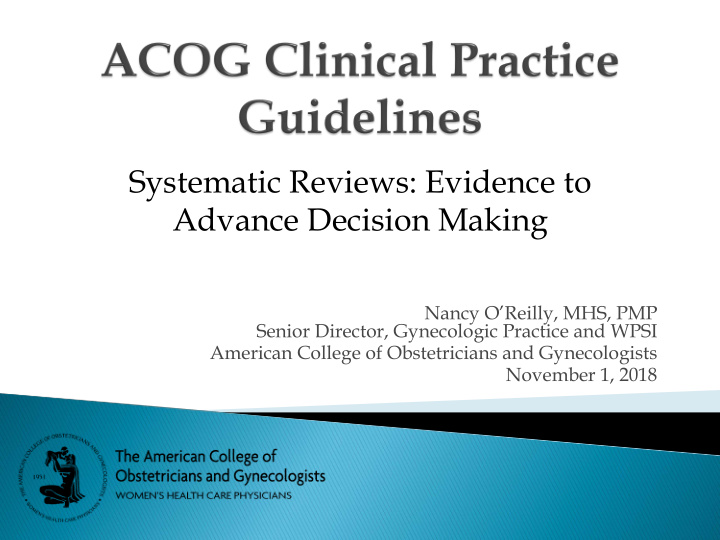



Systematic Reviews: Evidence to Advance Decision Making Nancy O’Reilly, MHS, PMP Senior Director, Gynecologic Practice and WPSI American College of Obstetricians and Gynecologists November 1, 2018
• First Practice Bulletin published in 1998 • 200 titles published since inception • Current Practice Bulletins ◦ 45 Obstetric ◦ 35 Gynecology
• Methodology summary listed on published document • Posted on ACOG website • Process undergoing update, so new process will be published and posted on website
• Authors and Chairs required to have no related financial conflicts • Members with potential conflicts have restrictions on input and voting • Conflicts for members and authors updated, evaluated and disclosed to committee throughout process • No external funding supports guideline development work
• Standing committees 1) Gynecology and 2) Obstetrics • 8-10 Ob-Gyn members with methodologic expertise • 2 public members • Collaboration in document development ◦ Ob-Gyn subspeciality organizatons ◦ Other Medical Specialty Societies
• Evidence Review ◦ In-house medical librarians ◦ MEDLINE database, Cochrane Library, Guidelines from other organizations or institutions ◦ Based on PICO elements identified in outline • Organized by level of evidence : o Systematic Reviews * o Randomized Controlled Trials o Observational Studies o Organizational Guidelines
• Based on previous USPSTF methodology • Evidence identified based on inclusion/ exclusion criteria • Recommendations directly linked to evidence
• Evidence maps to review supporting evidence quality and confirm recommendation • Recommendations: ◦ Level A – good, consistent ◦ Level B – limited or inconsistent ◦ Level C – expert opinion
• Executive Board • Clinical Document Review Panel ◦ Review by full ◦ Content review Executive Board ◦ Ob Panel and Gyn ◦ Board leadership, Panel representatives from ◦ 8 members each 12 ACOG Districts; ◦ Previous Practice partner organizations committee membership ◦ Primarily policy ◦ Written response to review comments
• Published in Obstetrics and Gynecology • Full guideline reviewed every 18-24 months at in-person meeting • Horizon scan for new evidence on-going for each topic • Updated when new clinical data would prompt change to recommendation(s)
• Engaged with AHRQ EPCs since 1998 ◦ Nomination of topics ◦ Participation in Technical Expert Panels ◦ Expert review of final reports • Partner with several EPCs including: ◦ Duke ◦ UNC/RTI ◦ Vanderbilt ◦ OHSU • Review EPC reports as partner organization to USPSTF
• Collaboration with EPCs allows identification and evaluation of most important clinical issues • Clinical experts/authors involved at each stage of S/R development • Input at PICO development stage • Prioritized as highest level of evidence to develop accurate recommendations • Serves as the anchor to our clinical practice guidelines
• Over 20 Practice Bulletin titles based on EPC Systematic Reviews • Practice Bulletin #137 Gestational Diabetes Mellitus (2013) • Practice Bulletin # 131 –Screening for Cervical Cancer (2013) • Practice Bulletin #129 – Osteoporosis (2012) • Practice Bulletin #107 Induction of Labor (2009) • Practice Bulletin #105 – Bariatric Surgery and Pregnancy (2009) • Practice Bulletin #96 – Alternatives to Hysterectomy in Management of Leiomyomas (2008) ► Additional topics in process
• Committee Opinions • CO 561 -Nonmedically Indicated Early-Term Deliveries (2013) • CO 559 - Cesarean Delivery on Maternal Request (2013) • CO 372 - The Role of Cystourethroscopy in the Generalist Obstetrician-Gynecologist Practice (2007) • Books and special projects • Hypertension in Pregnancy Task Force Report (2013) • Induction of Labor - Patient Safety Checklist (2011) • Neonatal Encephalopathy and Cerebral Palsy-Defining the Pathogenesis and Pathophysiology (2003)
Recommend
More recommend